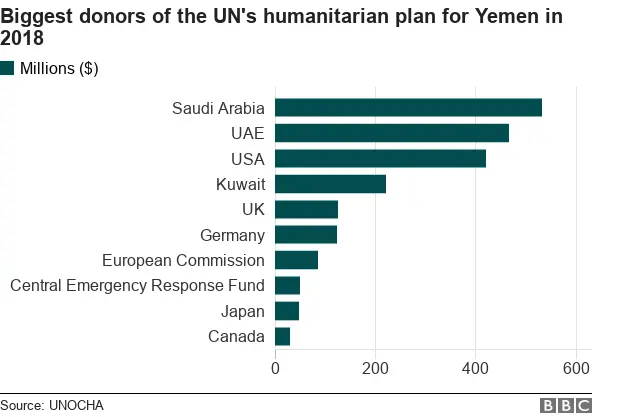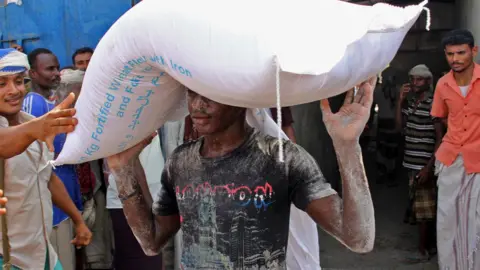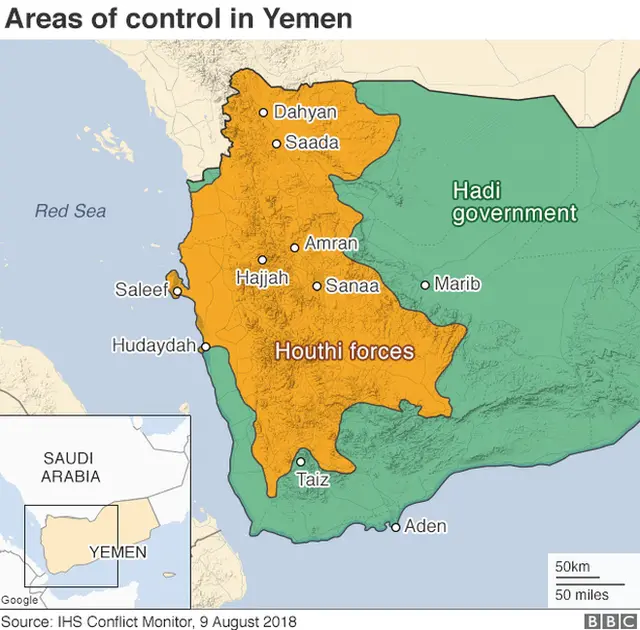Yemen war: Billions in aid, but where's it going?
 AFP
AFPUN-sponsored peace talks have been an important moment in the search for an end to the war in Yemen.
They have also brought a glimmer of hope that the desperate situation inside the country can be alleviated.
Images of severely malnourished children, outbreaks of cholera and warnings of whole communities on the brink of starvation have brought the urgency of finding a diplomatic solution into sharp focus.
Three-quarters of the Yemeni population is estimated to be in need of humanitarian support.
And the longer the conflict continues, the worse the situation is becoming.
That is despite very large sums pledged in aid for Yemen.
The UN appealed for close to $3bn (£2.4bn) to fund the humanitarian response in 2018. It will ask for $4bn (£3.16bn) next year.
So how much of this has been received, where is it coming from, and where is it going?

Biggest donors
International donors have been praised for raising large amounts of money for Yemen in response to the humanitarian crisis.
Almost all of the $2bn (£1.58bn) pledged at a UN conference in April has been received or formally committed.
The first pledging conference for Yemen held in 2017 was similarly as successful. The UN says 94% of the pledges - $1.1bn (£862m) - were fulfilled.
Half of the money pledged in this year came from Saudi Arabia and the United Arab Emirates (UAE). These are the two largest contributors to the UN's plan followed by the US, Kuwait and the UK.
The money has been given to dozens of UN agencies, international organisations and local NGOs. The largest recipients include the World Food Programme, United Nations Children's Fund, World Health Organization and the UN refugee agency.
These are large sums, but this UN-co-ordinated funding plan is only around half of the total aid committed for Yemen. It's estimated that in total $4bn has been made available this year.
Much of this extra funding has been provided by the UAE - a further $1bn - making it, by a significant margin, the largest humanitarian donor to Yemen this year.
The Red Crescent Society of the United Arab Emirates was the largest individual recipient in 2018.
So if such large contributions are being committed to Yemen, why isn't aid reaching those needing it most?

The view from inside Yemen
Nawal Al-Maghafi, Special Correspondent, BBC Arabic
The current conditions on the ground are seriously hindering the delivery and distribution of aid - far too little is reaching those desperately in need.
On the one hand, the Saudi-led coalition is enforcing a commercial blockade on sea and air routes into the country, and placing restrictions on relief supplies.
A total of 90% of imports are food, fuel, and drugs, and the blockade is effectively choking a country heavily reliant on these goods. Aid is also subject to long inspection delays as well as in some cases being rejected altogether.
Coalition forces have also bombed bridges linking Yemen's main port at Hudaydah with Sanaa, the capital city, which has meant trucks loaded with vital supplies are having to take other routes, adding many hours to journey times, increasing the price of delivery and, in some cases, making it impossible to deliver supplies at all to areas in desperate need.
On the other hand, local groups and warlords are also hindering the delivery of aid, and at times there is outright looting and selling on the black market.
Houthi rebels have blocked access to besieged cities such as Taiz and set up checkpoints into the capital, charging extra fees to aid agencies, who in turn have less available to spend on humanitarian aid.
Profiteers on both sides of the conflict are also intentionally creating shortages and spiking prices of certain items such as fuel and gas.

 AFP
AFPThe UN says humanitarian organisations are now able to reach eight million people a month but the warnings of a catastrophic famine have grown stronger.
So why isn't the situation improving?
Delivering aid in an active conflict is challenging - continued fighting and air strikes make it dangerous for humanitarian workers to gain access to people in need.
In the months of June and July this year, 86% of incidents where UN staff were delayed or denied access were due to administrative restrictions on movement - activities that require permissions from the authorities. Most of the rest were delayed by military operations and hostilities impeding humanitarian operations.
Suze van Meegen, a spokeswoman for the Norwegian Refugee Council, highlighted some of the difficulties faced by its staff operating in Yemen.
"Restrictions on the movement of humanitarian goods and personnel span challenges with security and logistics, as well as complex, changing bureaucratic impediments, delayed visa processes for international staff, and threats to the safety of Yemeni humanitarian staff - the ones working at greatest personal risk to help people in need."
However, no amount of aid can offset the economic collapse and spiking food prices that the war has produced, says Jeremy Konyndyk, a senior policy fellow at the Centre for Global Development.

Yemen depends on imports for almost all of its food. But ongoing fighting and a tightening of the two-year blockade by Saudi-led coalition forces has led to a significant drop in the amount of food entering the country.
The coalition, which backs the Yemeni government, says the blockade has been necessary to prevent the smuggling of weapons.
Between May and August this year food imports fell by 30%, according to the UN.
Famine warning
As a result of the blockade and a collapsing currency, food prices have soared, leaving a desperately poor population unable to buy food even though it is available in shops and on market stalls.
A pro-Yemeni-government assault on Hudaydah port, which supplies food and goods for just under two-thirds of Yemen's population and serves shipments of aid, threatened food supplies even further.
"If food imports dry up there's no way for the aid community to offset a famine," says Mr Konyndyk.



